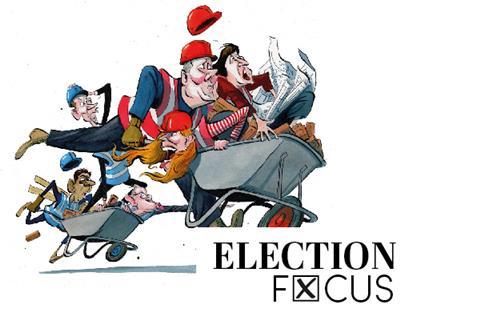Creative thinking is going to be vital in addressing decades of underinvestment in the fabric of our healthcare services

Nye is one of those theatre productions that sticks with you long after the curtain drops. If you haven’t heard of it, it’s a play on at the National Theatre about Aneurin (Nye) Bevan, the legendary politician credited with ushering in the NHS in post-war Britain.
Bevan’s extraordinary journey from a miner’s son in Wales, to becoming Labour MP for Ebbw Vale and then Clement Attlee’s minister for housing and health (could there be mileage in linking those two briefs once again?) is portrayed in dream-like flashbacks as he approaches the end of his life in a hospital bed.
Stay with me here – I’m not about to launch into full theatre critic mode; there is a link to construction, which I will come to. In fact, it was a construction contact of sorts who offered me the tickets when she at the last minute could not travel to London, much to her chagrin being not only a proud Welsh woman but having worked on hospital designs for decades – but that is by the by.
My point is that the subject matter of this production – which is at once about the death of a great, if flawed, man (played by the brilliant Michael Sheen), as well as the birth of a unique, if imperfect, health service – is extremely relevant right now for the people of this country.
Every week it seems there is coverage about funding issues affecting patient care and a growing consensus that staff and services are becoming dangerously stretched. No one in the UK can really escape the reality of the state of the NHS. Just take waiting lists as one example – you, or someone close to you, will probably have been on one at some point and know the deep worry delayed treatment can heap on individuals and their families.
The recent increases and the current construction work coming to market barely touches the sides when compared with the estimated investment needed
What most of us do not share, however, is a memory of life before the NHS. Nye takes the audience back to a time when free healthcare at the point of delivery was not a given, it had to be fought for politically – and at several key moments its fate was in the balance.
Bevan won the political battle back in 1948 when NHS started life; now, 76 years on, the decisions our next government will have to take could prove critical to its survival. Among those decisions will be how much politicians choose to prioritise capital spending on the health estate.
In our continuing pre-election series looking at key areas of public sector spending, we focus on where the funding gaps are when it comes to refurbishing and building the hospitals and other facilities the NHS relies upon.
>> Pre-election briefing: What can we expect for investment in the NHS estate?
In one respect the healthcare construction story is a relatively positive one. Spending has been on an upward trajectory for the past few years, with a 6.6% inflation-adjusted increase from 2022-23 to £2.6bn. Predictions are for it to rise by 2% this year and next. There is work to build surgical hubs and diagnostic centres through the Procure 23 framework, while some initial contracts for the much-anticipated (some might say over-hyped) New Hospital Programme are being let.
But let’s not kid ourselves. The recent increases and the current work coming to market barely touches the sides when compared with the estimated investment needed. The NHS costs its own maintenance backlog at £11.6bn, while 14% of its buildings date from before Bevan’s reforms, and half from before the 1980s. RAAC adds to the problems, affecting 41 buildings across different trusts.
Underinvestment has been a reality for over a decade, dropping most starkly during the coalition government’s austerity era, but even more sobering is the fact that the UK compares less favorably against other OCED countries going back five decades and more.
These trends can sound a little abstract but the consequences are real enough, with two serious incidents hitting the headlines recently when a ceiling collapsed on a patient at one hospital and a lift plummeting four floors injured a surgeon at another.
So, it is a pretty bleak picture for any incoming administration. The NHS Confederation says annual spending on deteriorating buildings and new technology needs to triple current levels to £6.4bn. That is an enormous bill by any standards, and for it to land just as the country faces very tight fiscal constraints is going to be a huge challenge.
Which is why the collective brain power of the public and private sectors is going to need to come up with some creative funding solutions. The industry experts we talk to in our coverage believe there are options out there. PFI may not be remembered fondly by many for understandable reasons, but clearly finding some different ways of leveraging private finance is going to be critical if we are to avoid the NHS estate falling into a permanent state of disrepair and the harmful knock-on effects on the productivity of its services and indeed the rest of the economy.
If you need a dramatic reminder of what is at stake, I highly recommend Tim Price’s imaginative production of Nye, which is also screened at cinemas nationwide on 23 April. It is essential viewing for anyone who has ever used the NHS, which is most of us.
Chloë McCulloch is the editor of ��ɫ����TV
Election Focus

As thoughts turn towards the next general election, the UK is facing some serious problems.
Low growth, flatlining productivity, question marks over net zero funding and capability, skills shortages and a worsening housing crisis all amount to a daunting in-tray for the next government.
This year’s general election therefore has very high stakes for the built environment and the economy as a whole. For this reason, ��ɫ����TV has launched its most in-depth election coverage yet, helping the industry to understand the issues in play and helping to amplify construction’s voice so that the government hears it loud and clear.
��ɫ����TV is investigating the funding gaps facing the next government’s public sector building programmes, looking at the policy options available to the political parties.
In the coming months our ��ɫ����TV Talks podcast will focus on perhaps the hottest political topic: the housing crisis. The podcast will feature interviews with top industry names who side-step soundbites in favour of in-depth discussions.
As the main parties ramp up their policy announcements, we will keep you up to date with their latest pledges on our website through our “policy tracker”.


























No comments yet